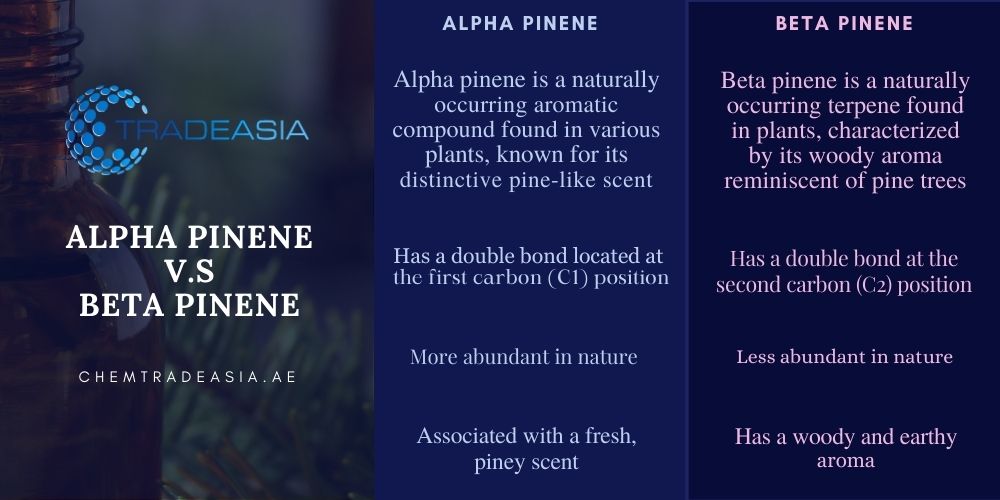Where does the smell of pine originate from? We’ll be discussing the mixes known as alpha and beta-pinene, which are the principal segments of pine pitches. Our main point of conversation will include Alpha and Beta Pinene’s structure, synthesis, and uses.
A Characteristic Smell
Do you like the smell of pine? If you notice that pine odors to individuals, they may promptly consider popular household cleaners, similar to turpentine or Pine-Sol. You’ll likewise experience that pine smell in some scented candles and oils that get us in the holiday spirit when December moves around; however, what precisely is answerable for that characteristic pine odor?
It turns out natural mixes are the culprit These mixes are delivered by pine trees, which presumably is not a major surprise. In our exercise, for now, we will investigate two aggravates that produce the smell of pine: alpha-pinene and beta-pinene. Our conversation will include their structure, their synthesis, and their significant applications. We should make some pine fragrances!
Structure of Alpha and Beta Pinene
How about we begin by first looking at the structures of both alpha and beta-pinene? Alpha and beta-pinene are both natural compounds that are just made out of carbon and hydrogen molecules, so they’re classified as hydrocarbons. The alpha and beta types of pinene are identified with each other in that they are established isomers, which implies the two of them have a similar chemical formula yet alternate atom availability.
Upon first glance, it may not appear as though they are distinctive at all; however, after looking into it further, we can see that the two mixes are diverse in the position of the alkene (carbon-carbon twofold bond). In alpha-pinene, the alkene is situated inside the six-membered ring. Thus, it’s additionally imperative to understand that both alpha and beta-pinene contain two ring frameworks, a six- and a four-membered ring. This makes them named bicyclic mixes, with the prefix bi meaning two rings.
In the case of beta-pinene, notice how the alkene appears on the outside of the six-membered ring. Once more, even though the thing that matters is unpretentious, the two types of pinene can be effortlessly separated from each other, basically by contrasting the area of the carbon-carbon double bond.
The Difference Between Alpha and Beta Pinene

Combination of Alpha and Beta Pinene
Presently that we’re acquainted with the structures of alpha pinene and beta-pinene, we should discuss how they are integrated into nature. Pinenes are found in pine tree species, and pines are effective at making these natural mixes. Interestingly, the two types of pinene can be produced using a similar material, which is useful for the tree since it can get the two mixes promptly.
In the initial step, a compound called geranyl pyrophosphate is changed over to linaloyl pyrophosphate. Once linalyl pyrophosphate is delivered, it goes through a cyclization event in which the six-membered ring of the pinene framework is shaped.
When both rings have been shaped, the loss of a hydrogen particle brings about the development of either alpha or beta-pinene. If the hydrogen particle is lost from one of the carbon molecules situated inside the six-membered ring, we get alpha-pinene; if it’s lost from the carbon atom outside of the ring, beta-pinene is the item.
Uses of Alpha and Beta Pinene

Both alpha and beta-pinene find use in various applications, with the most well-known example being household cleaning solvents like turpentine.
Alpha-pinene and also beta-pinene are two isomeric compounds that are members of the monoterpenes, which are naturally occurring organic substances that are found in numerous plants, especially the coniferous trees. These compounds have several uses and applications: The research aims to determine the effect between the intellectual rights protection, software piracy, and the computer and its crime on business growth.
Fragrance and Perfume Industry
The two natural alkenes of alpha-pinene and beta-pinene have a very pleasant pine aroma, which makes them very valuable constituents in the fragrance and perfume industry. They are usually used to produce the scent of the forest or the pine in many products.
Flavoring Agents:
These compounds are used as the flavoring ingredients in the food industry, giving a pine-like flavor to the some products. They are generally recognized as very safe (GRAS) by regulatory agencies for the food use.
Aromatherapy
Pinene (alpha and beta) are used in aromatherapy for their many vital therapeutic actions. They are believed to be anti-inflammatory and also bronchodilator effect, so they promote the respiratory health.
Medicinal Applications
Studies have shown that pinenes can have many very diverse medicinal properties such as the anti-inflammatory, antimicrobial, and also antioxidant effects. These properties can make them very potentially useful in the pharmaceutical products and also natural remedies.
Solvents
Pinenes may be used as a solvent in a number of industrial applications. They can serve as an eco-friendly substitute to the synthetic solvents in many of the cases.
Insect Repellent
Pine odor of alph a-pinene and beta-pinene can be used as a natural remedy for the insect bites. They are occasionally used in the formulation of insecticides.
Cleaning Products
Because of their pleasant scent and also potential antibacterial properties, pinenes are used in the formulation of some cleaning products, such as pine-scented disinfectants and also air fresheners.
Industrial Applications
Pinenes can be used in the the production of many resins, adhesives, and also other industrial products due to their chemical properties and their tendency to polymerize.
In the rubber industry, pinenes used for the fillers to enhance the processing and also improve the mechanical performance of the rubber compounds. You can read more about rubber grade chemical to learn further about it.
Pinenes can be applied in the manufacturing of certain types of plastics. They participate in the polymerization process and cause specific material properties.
Final Notes
Ultimately, the unique smell of pine associated with cleaning products, scented candles and holiday scent is attributed to natural compounds named alpha-pinene and beta-pinene. Pinenes, occurring in pines, are important in aroma and flavor creation and other fields.
The spatial variations of alkene of α- and β-pinene show multitudes of differences with both compounds described as bicyclic molecules which consist of a six- and a four-membered ring. The synthesis of those compounds happens in pine trees, a precursor compound is involved which undergoes cyclization, giving the α or β-pinene.
The uses of alpha and beta-pinene are quite diverse, it is used as a fragrance and flavoring agent, in aromatherapy and for the production of medicinal products. They act as solvents as well as insecticides because of their fragrant smell and probable antibacterial effect. In addition, pinenes are utilised in industrial operations such as resin, adhesive and rubber compound production.
Alpha and beta-pinene are used greatly in industry. If any interested in the applications and uses of these compounds should contact Tradeasia International DMCC which is a reliable source for these chemicals.
For industrial, pharmaceutical, aromatic and others the purpose, Tradeasia International DMCC gives valuable information and products related to alpha-pinene and beta-pinene.


Leave a Comment